The Ultimate Bench Press Guide (original) (raw)
The bench press once was used to test the strength of the feared Greek warriors. Today it’s one of the best exercises for your upper body. It’s also one of the three lifts for powerlifters.
You probably know the basics of how to bench press, but you may not realize that you can make minor adjustments to get major differences in results.
If you were to skip this guide, you could miss out on crucial information to achieve the strength and size you desire.
Read on to learn:
- Benefits of bench press
- When to incorporate bench press in your workouts
- Proper bench press form
- Bench press tips
- Bench press variations
- Muscles used in bench press (and how to tweak your form for more gains)
- Chest muscles used in the bench press
- Shoulder muscles used in the bench press
- Tricep muscles used in the bench press
Get ready to take your strength training journey to new heights!
This how-to bench press article is part of a series on the muscles used in powerlifting movements. You can check out the other articles on Muscles used in the squat and Muscles used in the deadlift.
Table of Contents
Toggle
- Benefits of Bench Press
- When To Incorporate Bench Press Into Your Routine
- What Is Proper Bench Press Form?
- Correct Bench Press Cues
- Bench Press Rules and Tips
- Muscles Used In The Bench Press
- Want to improve your bench press technique?
- Shoulder Muscles Used In The Bench Press
- Tricep Muscles in the Bench Press
- Frequently Asked Questions
- Final Thoughts
- What To Read Next?
- Resources
Benefits of Bench Press
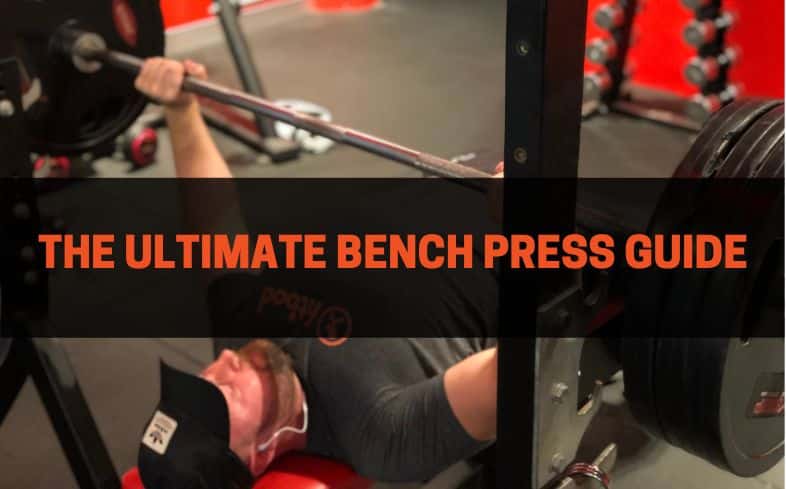
What do bench presses help with regarding health and strength?
Bench press helps:
- Increase bone mineral density
- Increases joint strength
- Increase muscle size of your upper body
Also, if you want to make those shirts fit nice and snugly around your chest and arms, the bench press is a tried and true exercise to get you there.
When To Incorporate Bench Press Into Your Routine
If you want to increase your overall upper body strength, a barbell bench press is one of the best exercises for you to include in your training program.
Another instance when you would want to incorporate bench press would be during lower body rehabilitation. If you cannot bear weight on your legs, it’s a great time to work on your bench press numbers.
Last but not least, if bench pressing is what motivates you to get into the gym more frequently, it’s a great idea to include bench press into your weekly program.
What Is Proper Bench Press Form?
Here are some detailed instructions on how to set up and execute the bench press.
- Maintain five points of contact during the entire exercise:
- Both Feet
- Butt
- Upper Back
- Head
- Pull the shoulder blades back and down firmly
- Brace your midline (or core)
- Place hands evenly on the bar
- Grip bar firmly and remove from rack or have a spotter assist you
- Maintaining rigid midline, lower the bar in a controlled manner to your sternum
- When the bar taps your chest press aggressively toward the ceiling
- Firmly lock out elbows at the top of the movement
- Repeat till pre-determined reps are completed
- Firmly place the bar back in the bench rack, have a spotter assist you if necessary
Correct Bench Press Cues
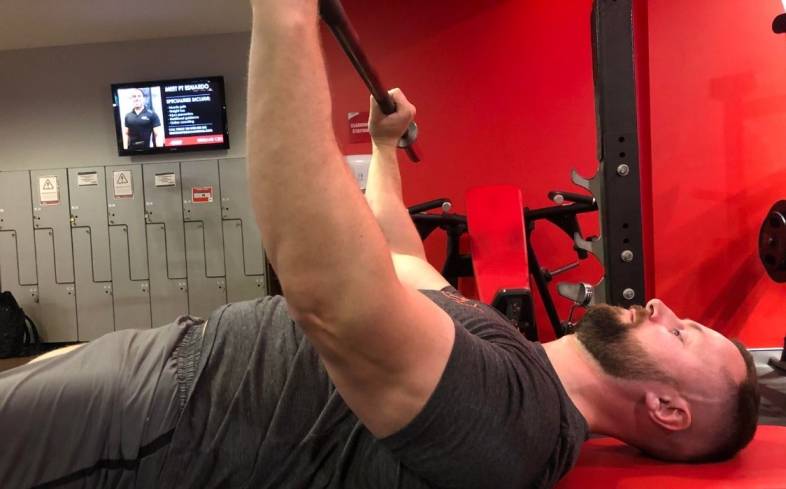
You may hear a lot of advice on your bench press journey. Here are some of our recommended cues to help you succeed.
- Brace your midline
- Drive your feet through the floor
- Exhale as you press
- Grip the bar firmly
- Don’t let your feet flail
- Lock your elbows at the top
- Squeeze your shoulder blades together
Bench Press Rules and Tips
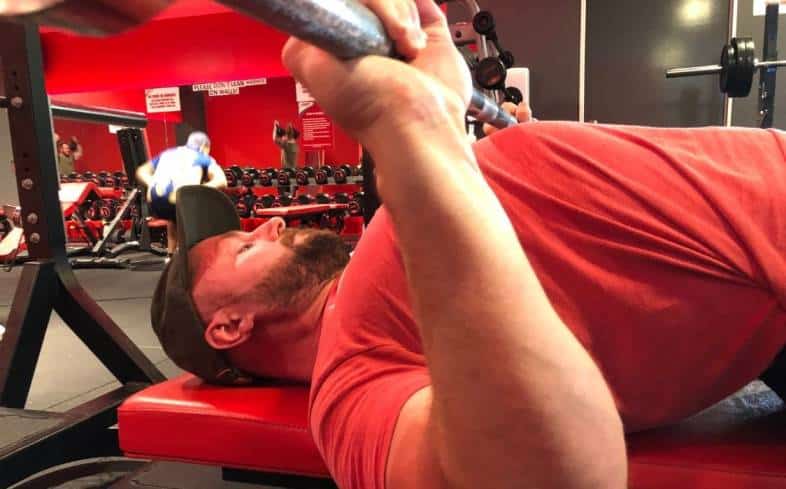
Here are some rules and tips when performing the bench press:
- Maintain five points of contact during the entirety of the lift
- Don’t bite off more than you can chew (i.e. don’t ego lift)
- Be sure to get a spotter if you need one
- Don’t forget about bracing your midline, there is more power in a tight core
- Don’t let your elbows flare out, maintain the same elbow angle the entire time
- Inhale at the top of the lift, hold as you descend, and exhale as you near the end of the lift
- If you’re benching alone, be sure to use safety straps or arms in case you miss the rep
- Remove all the plates from the bar when you’re finished
- Rack all your weights when you’re done
Muscles Used In The Bench Press
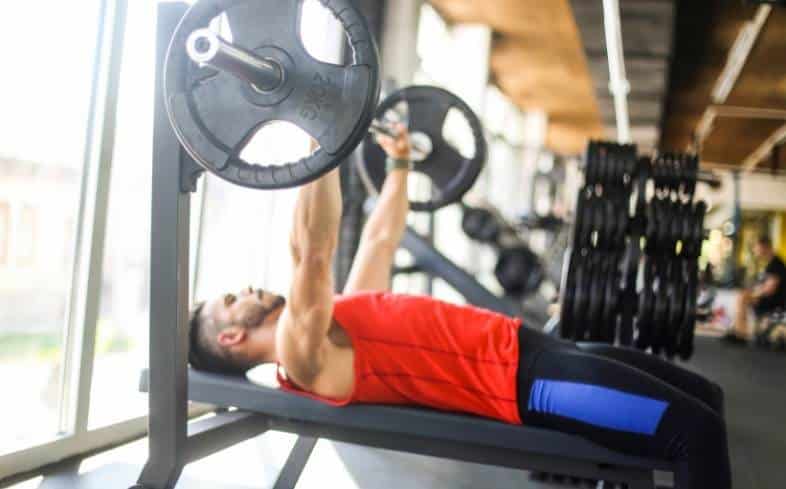
Chest Muscles in the Bench Press
The chest will largely be activated during the descent of the movement and at the bottom-end of the range of motion during the lifting phase. A wider grip (2X shoulder-width) has shown to activate the chest more than other grip styles.
If you prefer watching a brief summary of the muscles used in the bench press, here's me explaining:
Role of The Chest
The chest is one part of your bench press muscles and is made up of the ‘upper pecs' and ‘lower pecs'.

Anatomy picture courtesy of T-NATION
The upper pec includes the muscle fibers on your clavicle (collarbone), which help with shoulder flexion (like a pec fly).

The lower pec includes the muscle fibers on your sternum and ribcage, which help with horizontal flexion (bringing the arms straight overhead from the front).

Chest & Range of Motion
The pecs reach their peak activation during the bottom-end of the range of motion. However, the pecs are activated 2X as much on the descent compared with the lifting phase (Duffey 2008). This suggests that the pecs are highly activated when used to slow the bar.
If you can't control the weight on the way down, or you fail the lift during the lower half of the lift, it might be because of weak pec muscles.
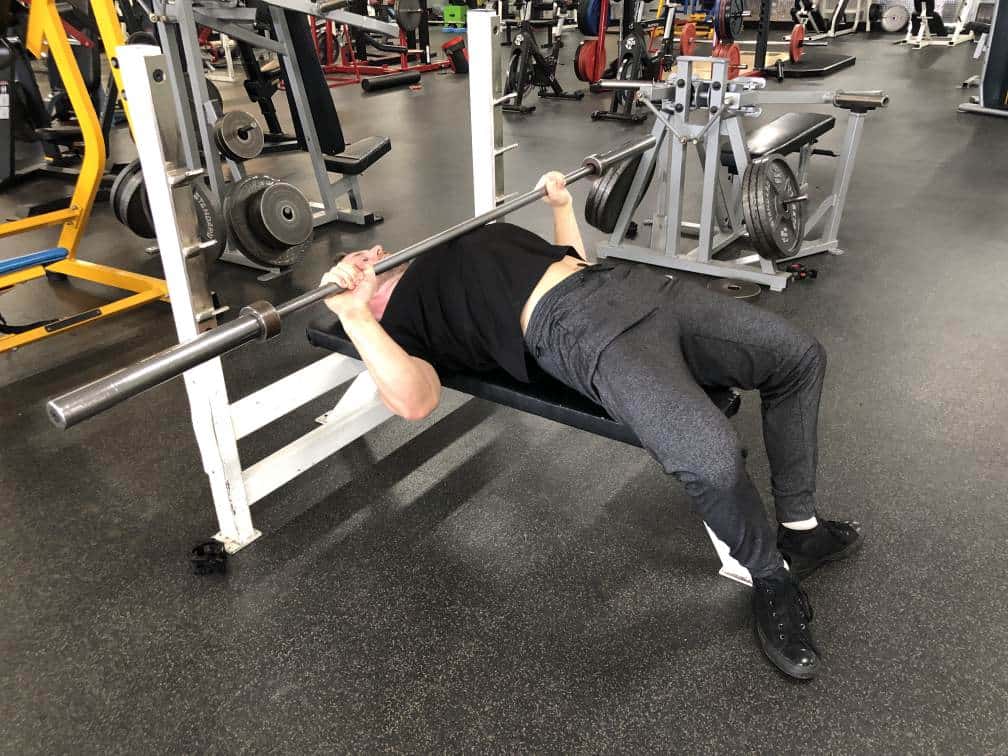
If you're weak at the bottom of the bench press, then your chest muscle are likely the weak link.
Chest & Grip
The wider you grip the bar, the pec muscles will activate more than the shoulders and triceps (Lehman, 2005).
A wide grip is considered 2X the width measured between your shoulders.
For example, while laying flat for a barbell bench press, if you measure the distance between your shoulders at 40cm, then a wide grip would be 80cm from index finger-to-index finger for a bar bench press.
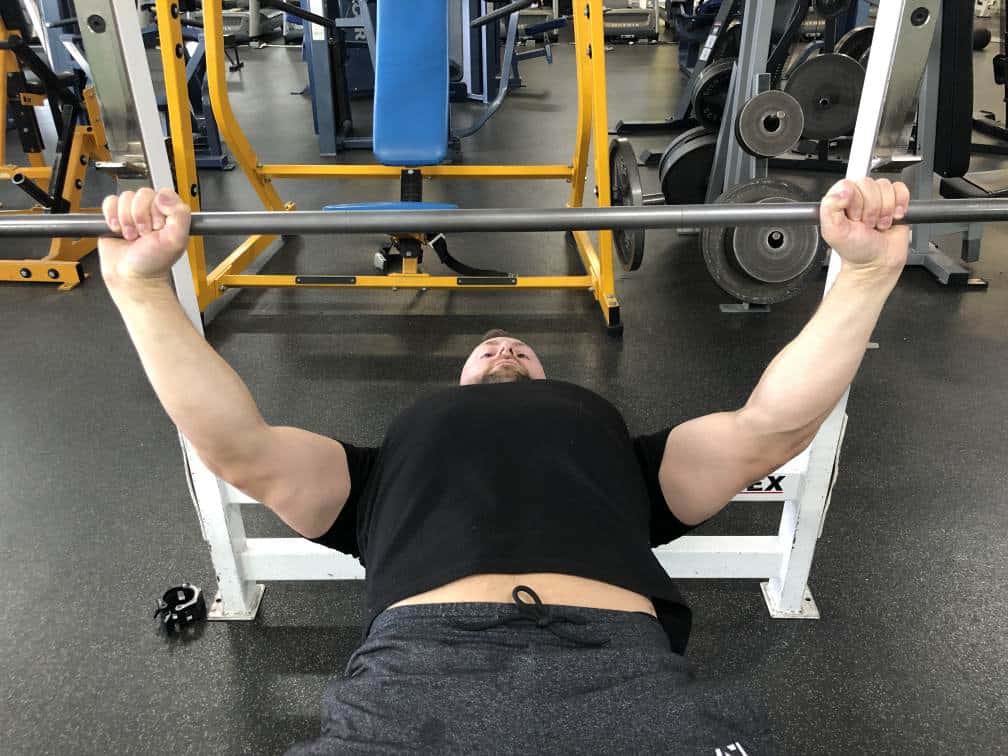
Wide Grip Bench Press With Barbell (2X shoulder width)
Based on research from Duffey (2008), grip width in and of itself may not be the reason why the chest is activated more in a wider grip. But rather, it's what the wider grip causes the elbow position to do. If the elbow position is directly under the bar (not in front), it will recruit the chest muscles more. If the elbows tuck inward, the triceps can also be activated in the wider grip.
Read more in my article on the Benefits Of The Close Grip Bench Press.
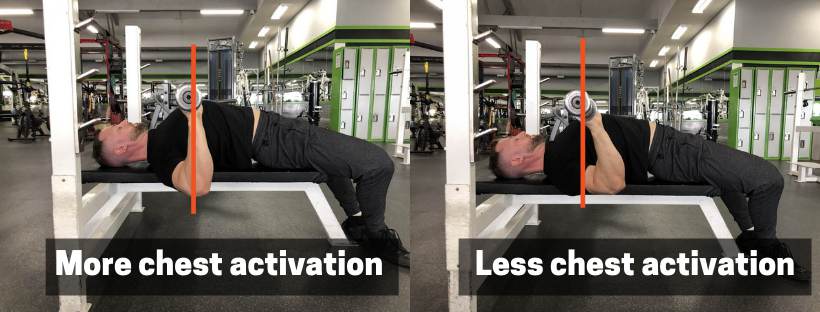
Chest Muscles & Bench Angle
It's been shown that an incline bench activates the upper pecs more than the flat and decline variations (Saeterbakken et al., 2017). Specifically, it's been shown that a 45-degree bench incline had the most activation in the pecs compared with other angles (Trebs, 2010).

However, there is no significant difference in pec activation when looking at the flat and decline variations.
Therefore, if you want more pec activation, perform an incline bench at 45-degrees, but you can pass up the decline bench because it doesn't offer any more pec activation than flat.
My Recommendation for Activating Your Chest
To train the chest more: Train on a flat or incline bench (at 45-degrees) in a wide grip. Additionally, because the chest is activated 2X more on the descent, you could perform a slow bench press variation, bringing the bar down with a 3-5 seconds tempo. Also, since the chest is activated more in the bottom range of motion, you could perform exercises that extend the time under tension on the chest, such as long pause bench press (3-sec hold on chest) or a dead stop bench press.
Related: Check out another great exercise for the chest muscles called the Plate Pinch Press.
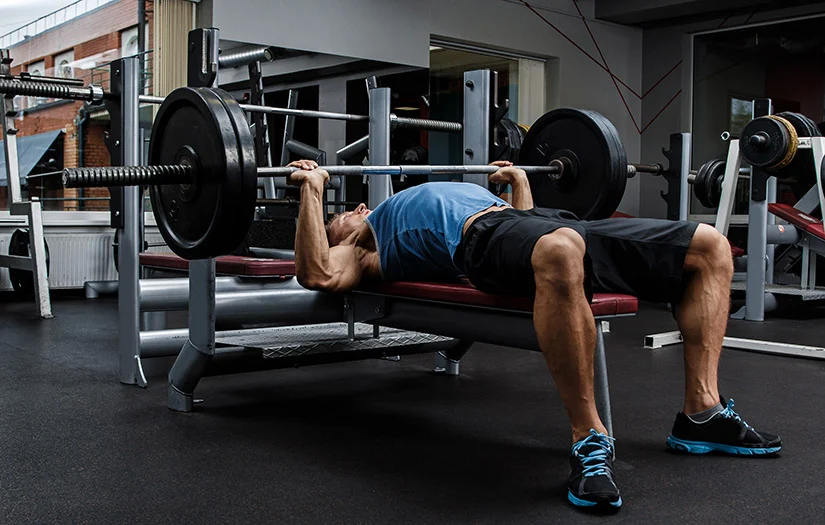
Want to improve your bench press technique?
Shoulder Muscles Used In The Bench Press
The shoulders (anterior delt) will largely be activated during the mid-range of the bench press. Regardless of the grip you choose, the shoulders will activate similarly across different widths. Furthermore, the shoulders are most activated using a high incline bench (55 degrees +) compared to other bench angles).
Read more in my article on How Do Powerlifters Train Shoulders?
Role of The Shoulders
The shoulder is made up of the anterior deltoid (front), medial deltoid (side), and rear deltoid (back).
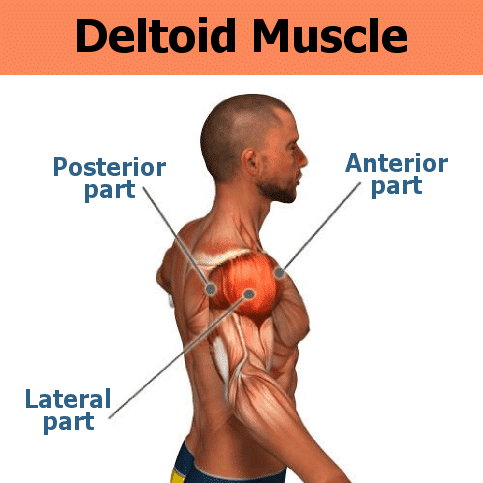
Picture courtesy of Jason's Take
Only the anterior deltoid is a prime mover in the bench press. Its role is shoulder flexion (bringing the arms straight overhead from the front).
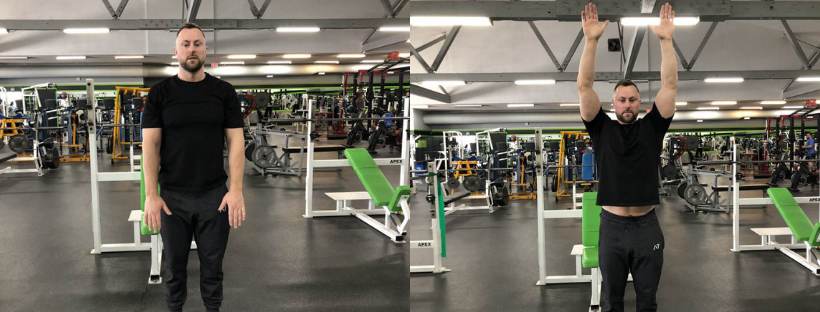
Shoulders & Range of Motion
The anterior deltoid is utilized the most in the mid-position of the bench press. Unlike the chest and triceps, which have different activation levels during the descent and lift phase, the shoulders are equally active when lowering and lifting the bar, and its peak activity occurs very close to the middle of the movement, regardless of which direction the bar is moving (Duffey, 2008).
If you get stuck in the mid-range of the bench press, it might mean you have weak anterior delt muscles.
Shoulders & Grip
Various studies have shown that there is no statistical difference between shoulder activation and grip width on bench press (Saeterbakken et al, 2017, Duffey, 2008, Lehman, 2005).
You can expect that your shoulders will be activated similarly whether you choose to have a narrow, medium, or wide grip on the bar.
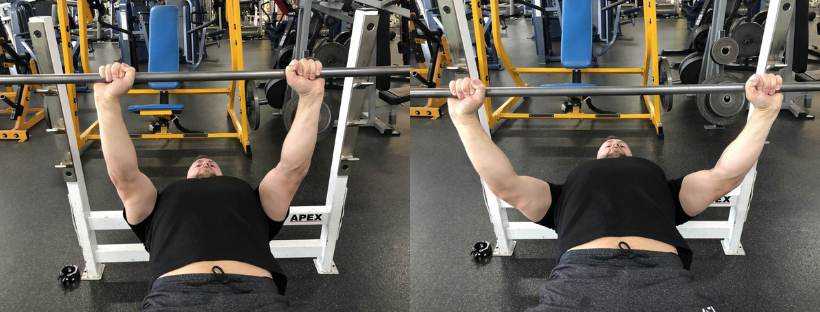
Same muscle recruitment regardless of grip
Shoulder Muscles & Bench Angles
The anterior delt is activated more throughout an incline bench variation. Studies have shown that the higher the incline, the more the anterior delt is activated (Trebs et al., 2010).
While I mentioned that the pec muscles are most activated at a 45-degree angle before having diminishing returns, the anterior delt becomes more activated the higher the angle (55+ degrees). Therefore, as you start to increase the bench angle higher than 45-degrees, the pecs do less of the work, and the shoulders do more. ‘
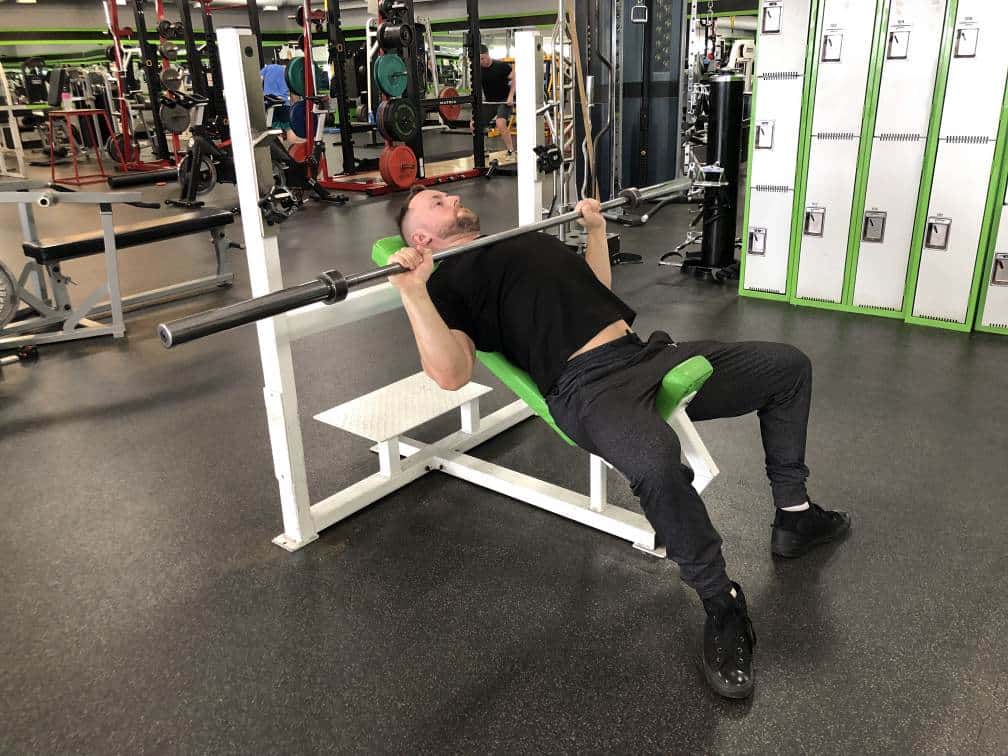
There is also no difference between shoulder activation on the decline and flat bench. So again, if you're looking for more shoulder activation, perform a high incline or flat bench, but forget about decline.
My Recommendation for Activating Your Shoulders
To target the shoulders more: Train on a flat or incline bench (greater than 45-degrees) in a wide grip. Remember, the greater the incline, the more anterior delt activation. On a flat bench, the shoulders are most activated in the mid-range.
Therefore, you can consider doing exercises that emphasize the mid-range of motion, such as a 2-stop bench press (where you stop and pause at the halfway point on the way down and up).
If you're weak in the mid-range of the bench press, check out my article where I discuss how to fix it.
Tricep Muscles in the Bench Press
The triceps (lateral and medial head) will largely be activated during the lock-out phase of the bench press. A narrower grip (shoulder-width) has shown to activate the triceps more. Stick to the flat bench as the triceps decrease in muscle activation by up to 50% on incline bench variations.
Read more in my article on How Do Powerlifters Train Arms?
Role of The Tricep
The triceps are made up of the lateral, medial, and long head.
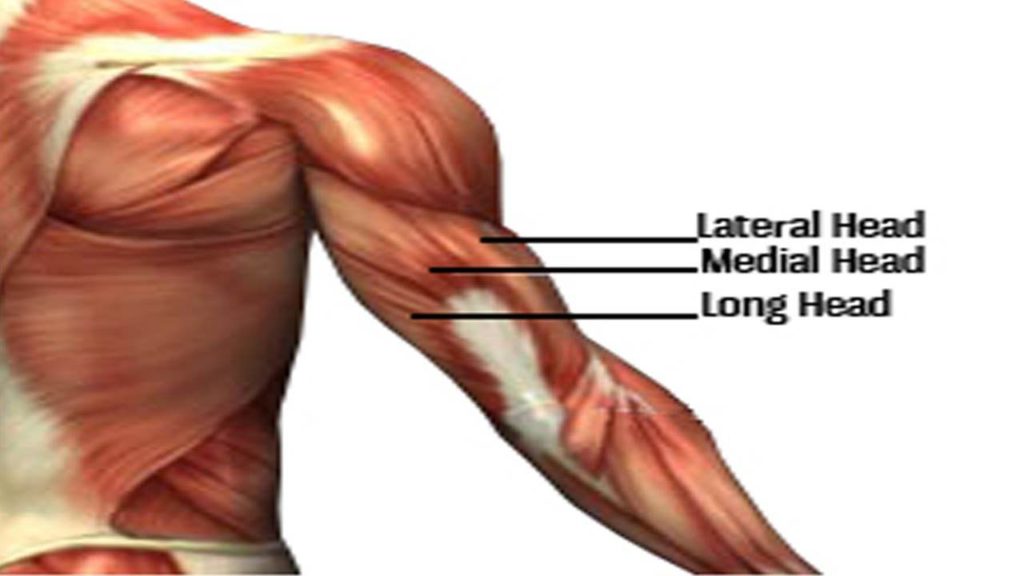
Picture courtesy of Human Anatomy Lib
Only the lateral and medial head of the tricep are involved in bench press as a prime mover. Their role is extending the elbow (going from bent to locked).
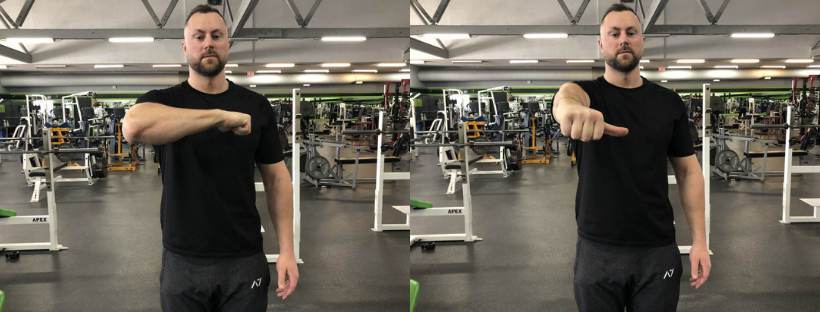
Tricep & Range of Motion
The triceps reach their peak muscle activation at the lock-out when the elbows extend (Duffey, 2008). I mentioned the pecs are highly activated during the descent, but this is the opposite for the triceps. They are relatively inactive as you bring the bar down to the chest and only activate at the top of the movement on the way up.
If you fail the weight at the top end, it might be because you have weak triceps.
One of the best exercises for working the top-end range of motion is the boarded bench press.
Tricep & Grip
The triceps are activated the most in a narrow grip (Lehman, 2005). A narrow grip can be considered a shoulder-width grip.
For example, if you measure the distance between your shoulders at 40cm, then a narrow grip is when your grip is 40cm between your two index fingers on the bar.
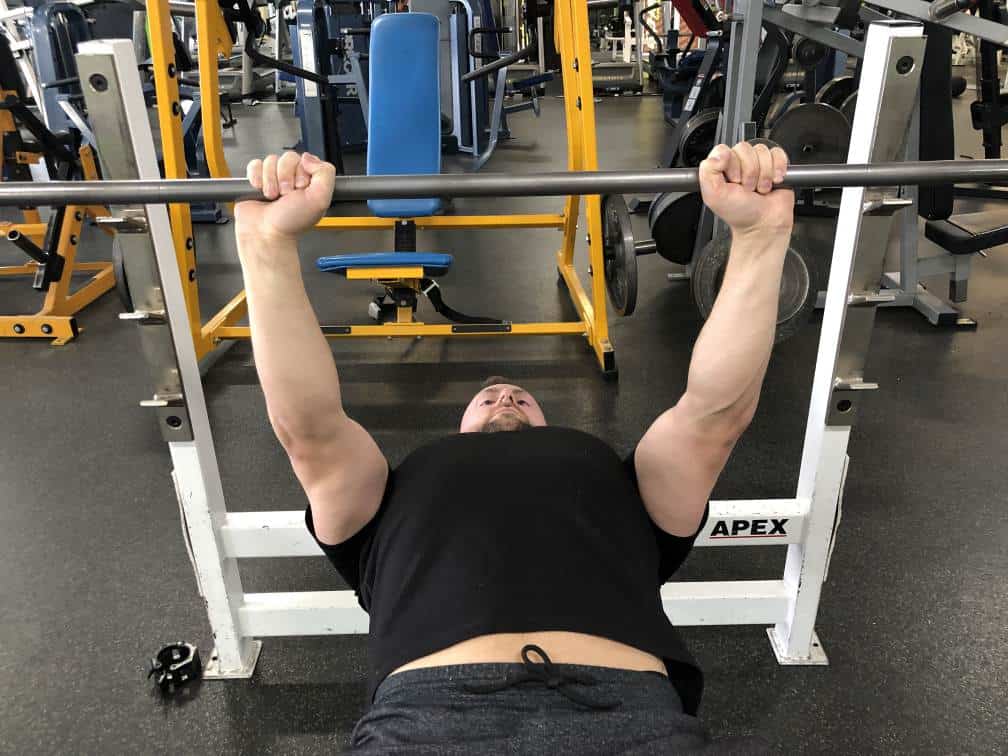
At this grip width, the triceps are activated 2X as much as a grip twice the distance (Lehman, 2005).
However, as I stated above, studies have shown that the elbow position in relation to the bar largely determines muscle activation (Duffey, 2008). So if the elbows are tucking in front of the bar in a narrower grip, then more triceps will be activated. But, if the elbows are stacked directly under the bar, then the pecs will have more activation (not more than in a wider grip, but some).
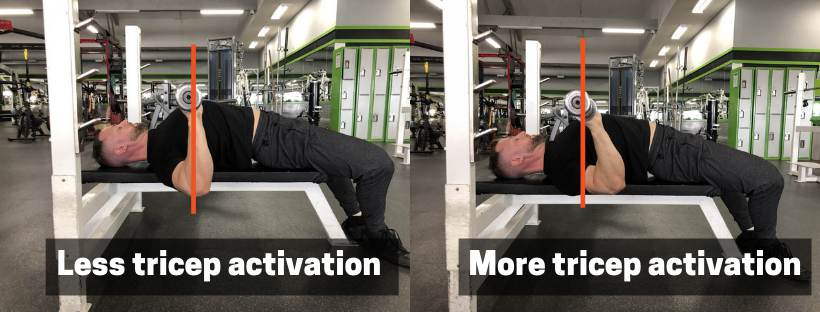
Tricep Muscles & Bench Angles
There is 50% less tricep activation on the incline bench when compared with the flat and decline variations (Saeterbakken et al., 2017). So while you may get more chest and shoulder activation with higher inclines, tricep activation drastically reduces.
On the decline bench, the triceps are similarly activated compared to the flat bench (Trebs et al., 2010). So, if you wanted to target the triceps, you could either do a flat or decline bench. But the decline is generally a more awkward set-up, so I would just stick to flat benching.

My Recommendation for Activating Your Triceps
To target the triceps more: Use a narrow grip (shoulder width distance) on a flat or decline bench. Also, since the triceps are at their peak activation during the lock-out of the bench press, you could perform top-end variations such as board presses or band presses.
Read my article on the best tricep exercises to increase bench press strength.
Curious to know if the bench press works the bicep muscles? Check out my article on Does Bench Press Work Biceps? (Yes, Here's How).
Frequently Asked Questions
How Wide Should You Grip the Bar for the Bench Press?
Start with a slightly wider grip than shoulder width to find optimal width. Try a few reps with a slightly wider and narrower grip to see which is most comfortable. A wider grip lets you lift more but adds more shoulder stress. A narrower grip adds less shoulder stress, but you won't be able to lift as much.
Is Bench Pressing Bad For Your Shoulders?
Programming bench too many times a week, using bad form, and biting off more than you can chew (i.e. too heavy too soon) can be bad for shoulders. If you are getting the appropriate amount of rest and recovery, practicing good form, and not ego lifting between and during your bench press sessions, you’ll be alright.
How Many Reps and Sets Should I Do For Bench Press?
High reps, low weight is good for muscular endurance. Low reps, heavy weight is good for strength, and medium reps, medium to high weight is good for hypertrophy. Your goals dictate the amount of reps and sets you should do during a bench press session.
How Often Should I Bench Press In My Workout Routine?
It is not uncommon for novice lifters to see a bench press, or bench press variations, in their workout routine once or twice a week. More advanced lifters may be able to squeeze in another day. It largely depends on your lifting abilities, recovery, and goals.
Read more: Take a deep dive into bench press progressions
Final Thoughts
You should now be convinced that in order to target each muscle group involved in the bench press there will be different angles, grips, and ranges of motion that will be most effective.
So how should you use this information?
If you're a powerlifter, like most of our audience will be, you should prioritize the flat bench press over all variations.
My recommendation for people who want to maximize musculature is to practice on a flat bench press and strive to be in a wider grip. A good starting point for a wider grip would be a 2X shoulder width distance, and then adjust based on mobility and level of comfort.
With that said, it's important to target each muscle group involved in the bench press through different variations.
What To Read Next?
- Bench Press Tempo: How Fast You Should Bring The Bar Down?
- Should Your Elbows Be In or Out For Bench Press?
- Why Do Your Arms Shake In The Bench Press? (6 Reasons Explained)
- Can You Build Muscle With Powerlifting? (Yes, Here’s How)
- Does Forearm & Grip Strength Help Bench Press? (Yes, Here’s How)
- Dumbbell Bench Press vs Barbell Bench Press
- How To Increase Your Bench Press By 50lbs (Step By Step)
- Looking for a challenge? Try this bench press pyramid.
Resources
Duffey, M. A Biomechanical Analysis of The Bench Press. A Dissertation in Kinesiology, Pennsylvania State University. 2008. https://etda.libraries.psu.edu/files/final_submissions/4136
Lehman, G. The Influencer of Grip Width and Forearm Pronation/Supination on Upper-Body MyoElectric Activity During The Flat Bench Press. Journal of Strength and Conditioning Research. 2005;19(3):587-591) [Semantic Scholar]
Trebs AA, Brandenburg JP, Pitney WA. An electromyography analysis of 3 muscles surrounding the shoulder joint during the performance of a chest press exercise at several positions. J Strength Cond Res. 2010;24:1925–1930. [PubMed]
Saeterbakken, A., Mo, D., Scott, S., Anderson, V. The Effects of Bench Press Variations in Competitive Athletes on Muscle Activity and Performance. Journal of HUman Kinetics. 2010;57:61-71. [National Library of Medicine]